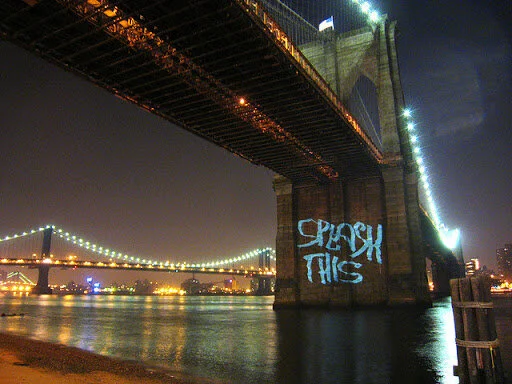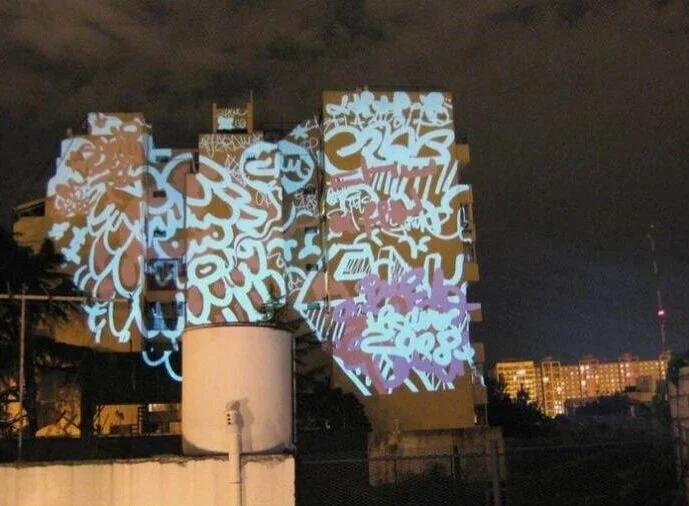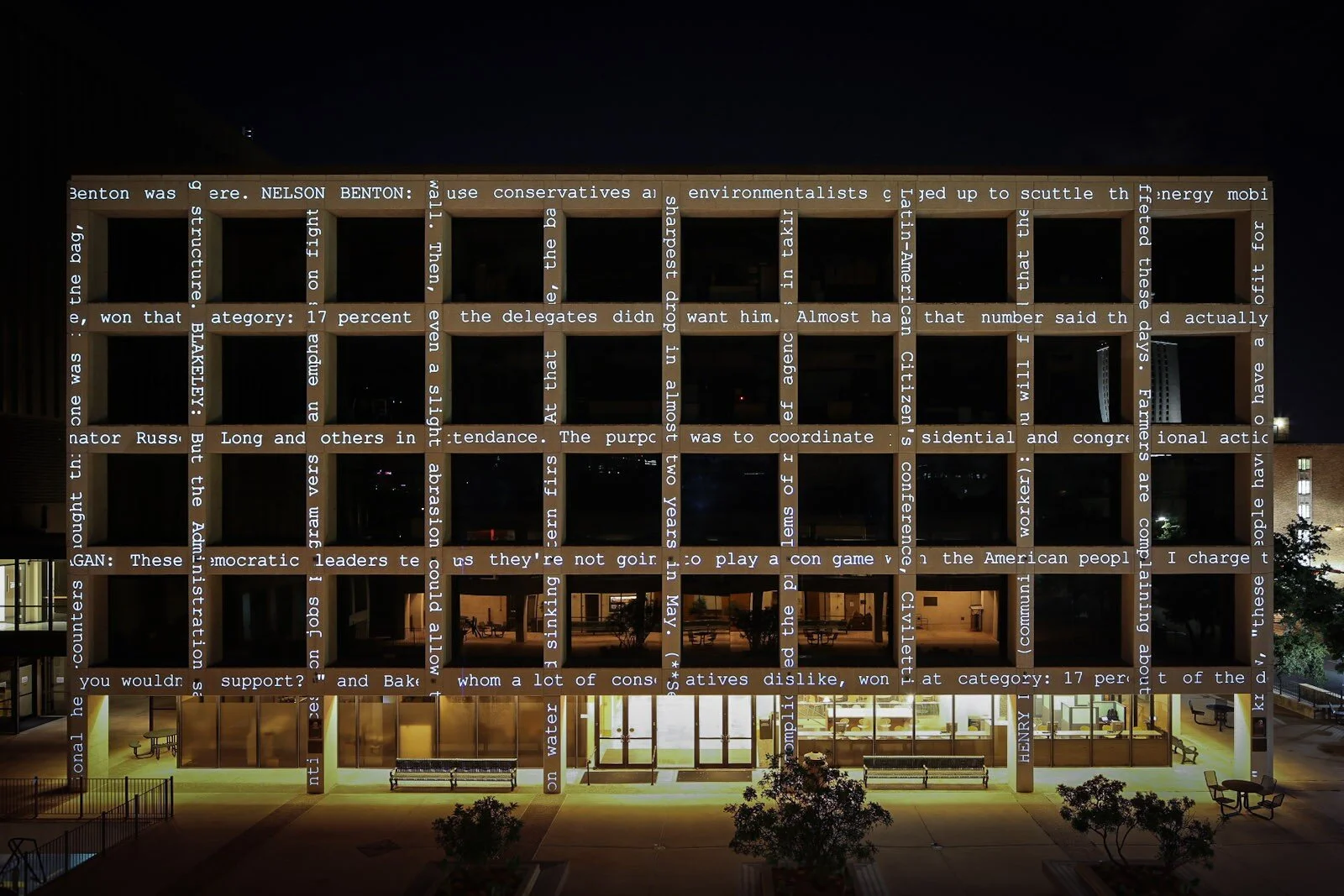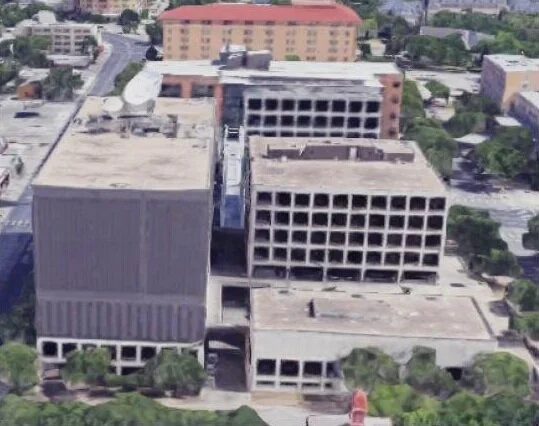This Is Not Graffiti
May 2018.
Multimedia work — graffiti, animated short film, projection.
3 minutes.
This Is Not Graffiti: Media Projections, examines the role of animation and projection in the discourse of street art. Named after Kester Rattenbury’s anthology on media representation of the built environment, This Is Not Architecture: Media Constructions, this multimedia work aims to challenge contemporary definitions of street art by reassessing which materials and practices constitute graffiti, a sub-category of street art characterized by its illicitness. Currently, discourse on graffiti pertains overwhelmingly to physical interaction with a surface using materials like paint, wheatpaste, markers, stencils, stickers, blades, etc., but tends not to examine illicit ephemeral works projected onto a surface. Most public projections tend to be state-sanctioned, and very few graffiti artists flirt with these kinds of projects. The questions I ask: Must graffiti be tangible, or may it be ephemeral? Are illicit projections on a public surface an act of vandalism that constitutes graffiti, and if so, where does the future of this artform lie?
This Is Not Graffiti is a one-time viewing of a projected animated short film composed of rapid, successive still images of graffiti documented around Austin, Texas. These works are not limited to aerosol spray paint, house paint, wheatpaste, stencils, stickers, scribbles, etchings, etc., but any artwork identifiable as an act of vandalism upon or within public space.
Each photograph of a piece of graffiti, taken by myself on a digital camera, serves as not just a document, but an aspect of the mise-en-scène and a frame to be acted upon by successive frames, defining the segmentation of the animation. The work thus appears animated as the artwork shifts and changes between each frame along the x, y, and z axes. Grouping together images of work by the same graffiti artist endows the animation with discrete segments characterized by the works of individual artists. Moreso, grouping together images of work by different artists across various locations constructs a visual map of human interference with public space. Projecting the animation on a public surface forms a shared network amongst different artists and their works into one localized point. Each photograph represents a public surface for graffiti exhibition, so the projection is the centralized exhibition of all these different spaces. If animation is a continuous trajectory of motion across time due to the rapid succession of different frames, then graffiti animation grants movement across different public spaces and nodes of exhibition.
The projection acts as both graffiti exhibition and animation screening. Projected on a public surface, the animation assumes the role of graffiti, displacing the representation of an interface by temporarily acting upon it. While not physically interacting with the public surface in the same manner as paints, stencils, or etchings, the projection constructs a new mode of seeing and interpreting the surface, not as just a facade or aspect of the environment, but as a platform for art exhibition. The public surface becomes part of the mis-en-scène of the animation, “part of the experience, not ‘just’ the artworks, but also the space in between and around them” (Edwin Carels, 24). Just as the process of creating graffiti involves a redistribution of the hierarchy of images in a public space, the public animation projection transcends its cinematics by transforming the environment into a space for reassessment and correction, assuming control over its representation.
As graffiti faces erosion, erasure, and censorship, it does not stand the test of time in the same way graffiti animation can. Photographing graffiti indexes the artwork in a different media format compared to its current mode of exhibition, documenting it in a temporality distinctly different than the one in which it exists. Carels claims that animation’s “most distinctive feature in comparison with live-action cinema is above all the art of producing, not reproducing time” (294). Projecting images of graffiti photographed at different locations mimics the temporality in which graffiti physically exists; the animation does not necessarily condense time, as one would expect from a timelapse video of graffiti that erodes away, but by limiting the duration in which the images appear on the surface. To use Thomas Gunning’s example of blow book animation, each projected image is “an image of potential motion… vibrating with the possibility of change,” just as physical graffiti imbues itself with the potential to disappear (55, 59). Thus, each frame change in the animation represents the inevitable erasure of the physical object, with each new image acting as the appearance of a new graffiti piece. Thus, the projection itself portrays the contestation over public spaces and surfaces amongst graffiti artists.
As Craig Campbell illustrates in his essay, “Minor Marks and Modifications: Foot Traffic,” graffiti “is an oppositional practice governed by the question of legitimacy” (16). By sheer virtue of semantics and word-association, the graffiti artist as compared to the mural artist remains in continual contestation with city administration and territorial claim. Their interferences with the materiality of the city challenge and displace the strategic, technological landscapes of the built environment. Such intervention with physical surfaces is the dilution of the image of the functionalist organization. Michel de Certeau claims in “Walking in the City” that graffiti art undermines the strategies taken by the functionalist organization to negotiate places “of transformations and appropriations, the objects of various kinds of interference,” becoming these transformations and “contradictory movements that counter-balance and combine themselves outside the reach of panoptic power” (96).
The projection itself portrays the contestation over public space between graffiti artists and surface. Projection bombers, graffiti artists who use projections as their medium, take a tactical approach to adapting the environment, reassessing public space into canvases on which they construct their own grammars of artful expression. If “the act of walking is to the urban system what the speech act is to language,” then the tactical rerouting of pedestrian traffic accounts for the irregularities of urban design and the grammatical errors not considered by city planners (de Certeau, 98). To further extend this metaphor, graffiti expounds upon the speech of the pedestrian, acting as a sudden break from speech itself into the realm of onomatopoeia. No language nor grammar can spell out or put into words the explosive verbalizations of onomatopoeia, and so dictionaries tend not to include them. Similarly, graffiti is so discreetly oppositional that it cannot be explained by the grammar set forth by urban strategy. As a result, the functionalist organization strategizes methods of replacing such “tactics of users who take advantage of ‘opportunities’” by incorporating street art into the redistribution of urban space or by removing it altogether (de Certeau, 95).
Surfaces transform into exhibition spaces and then back into surfaces — canvases are flattened by the film plane into a photograph. A new photograph cannot be taken until the image on the canvas changes. The succession of stop-motion images mandates the duration with which each painting exists as part of the urban landscape. To project street art is to index it twice; once through a photograph, and again by exhibiting it on a surface. To exist permanently in the animated film, each graffiti artwork must exit the public space. This act signifies a return to the temporary nature of street art and the tactical implementation of its production. However, through projection, the artwork returns to the public space, again assuming its role as graffiti.
One main concern with the animation itself is the ethics of projecting the works of graffiti artists without their permission. Some detractors of This Is Not Graffiti might argue that I require consent from the original artists to include their work in my own. Despite being only three minutes in duration, my animation includes the works of hundreds of artists, none of whom I can contact because the nature of graffiti practice is to remain unidentifiable and unknown. Even further, my animation includes pieces by several people who likely would not consider themselves artists or even hold recollection of creating the pieces themselves; random acts of vandalism like scribbles and doodles that do not constitute the larger oeuvre of an artist, but a passerby. Detractors from my project ask, “Do these artists and random vandals deserve notification, and perhaps payment, for the use of their works?”
Indeed, the ethical debate produces many questions about the respectable verisimilitude of graffiti practice. Like sampling music, This Is Not Graffiti is an art piece contingent on someone else’s work for its actualization, and the original musician can demand payment. Similarly, a state-sanctioned mural artist could demand the right to sue a photographer who used the image of their artwork without permission. However, graffiti artists exist outside the legal realm of respectability because the nature of their work is both public and illegal. By acting in the public space, the ownership of their work transfers to the public. A graffiti artist cannot spray-paint a dumpster and sue the cleanup crew that removes it because they do not own the interface on which it exists. Only by owning a surface can an artist claim ownership of the art they create on it. Likewise, they cannot sue anyone who uses the image of their work without permission because graffiti practice is illegal. Furthermore, graffiti artists risk lawsuit from the state and building-owners when they out themselves, so the hundreds of participants in my animation projection have no choice in their inclusion.
So, while traditional graffiti artists redefine and rework public spaces for themselves, This Is Not Graffiti showcases my ability as a photographer and animator to claim ownership over their artwork. Because graffiti works are public, they become my property when I photograph them. By assembling these images into an animation and projecting them on the CMB building, I redefine and rework the work of these graffiti artists into my own artwork. In displacing the territory from which they originate by relocating them to my place of preference, I generate authority over the graffiti artists themselves, staking a claim in the space of their own artwork. This Is Not Graffiti, in turn, is not just an experiment in graffiti practice and light projection, but also a performance that both highlights and diminishes the powers graffiti artists grant themselves through their practice.
The summation of this figurative struggle between artist and space is represented in the site-specific location of This Is Not Graffiti’s one-time projected viewing. The site of projection is a building surface local to Austin and perhaps the place most fundamental to the spawning of the idea of graffiti animation: the University of Texas Jesse H. Jones Communication Center (CMB), home of the KLRU public television station and the film studios and classrooms where I spent the entirety of my undergraduate career. Housed diagonally across the courtyard from the CMB is Ben Rubin’s And That’s The Way It Is (2012), a public work that projects text onto the neighboring building (CMA) nightly. A part of The University of Texas’ Landmarks collection, the piece is described as follows:
Visible every evening in the Walter Cronkite Plaza, And That’s The Way It Is projects an interwoven grid of text from two sources: closed caption transcripts of five live network news streams and archival transcripts of CBS Evening News broadcasts from the Cronkite era… Rubin’s software scans for various patterns in speech and grammatical constructions, and then selects the sequences of text. The artist visually distinguishes these sources by using two typefaces that evoke the technologies of their respective eras: Courier represents the Cronkite material, and Verdana is used for the live broadcasts.
And That’s The Way It Is translates the spoken language of televised evening news into written fragments. The layering of information—textual and visual, contemporary and historical—engages the viewer in multiple ways: cerebrally, as a distilled source of information, or viscerally, as a purely visual experience of luminescent crescendos and diminuendos…
The transformation of the familiar into the unexpected, captured through gracefully simplified forms, results in works that are quietly provocative and that gently turn viewer into participant.
And That’s The Way It Is acts as a mural because it is sanctioned by the university and Rubin was recruited by the College of Fine Arts to create and install it. The difference between And That’s The Way It Is and projection bombing is the authority of the artist to display their work on a building. Because the university owns the CMA and hired Rubin to project his mural onto its façade, the agreement between state and artist is one of mutual, legal agreement. In contrast, an artist who illicitly projects onto a building owned by the university would not have this consent. No contract would be in place to give the artist the legal position to install their artwork on the building. As such, their projection would act as graffiti for two reasons. First, the artwork would deface the building’s façade through interaction of material and light, and second, the artist lacks the authority from the building owner to use their property as an interface for their artwork. To project This Is Not Graffiti, an illegal, illicit, non-sanctioned work adjacent to And That’s The Way It Is, a state-sanctioned work financed by a public institution, is to call into question the perception of graffiti versus public street art. What role might the ephemeral graffiti artist play in challenging state and private ownership of buildings?
Turning to Rattenbury for advice, he reminds us in This Is Not Architecture that, “architecture is driven by belief in the nature of the real and the physical: the specific qualities of one thing — its material, form, arrangement, substance, detail — over another. It is absolutely rooted in the idea of ‘the thing itself.’ Yet it is discussed, illustrated, explained — even defined — almost entirely through its representations (xxi).” In this case, might projection bombers find solace in the idea that their public intervention is not actually graffiti, but just its representation? Might artists like Kris Graves, Zach Lieberman, Julien Nonnon, Paul Notzold, and Krzysztof Wodiczko and collectives like Straight Through The Wall find ways to continue their work without police surveillance or intervention if only tangibility, not ephemerality, is defined as vandalism? Or will new laws circumvent their efforts, characterizing the act of wheatpasting the same as shining a light onto a building? Will artists get double-booked for using a flashlight to help aim their aerosol canisters?
Can an institution like a university really tell the artist to turn out the light?
Campbell, Craig. “Minor Marks and Modifications: Foot Traffic.” In TranscUlturAl: A Journal of Translation and Cultural Studies, vol. 6, no. 1, edited by Elena Siemens, 16-27. Alberta Canada: University of Alberta Library, 2014.
Carels, Edwin. “Spaces of Wonder: Animation and Museology.” In Pervasive Animation, edited by Suzanne Buchan, 292–316. New York, NY, USA: Routledge, 2013.
De Certeau, Michel. The Practice of Everyday Life. Berkeley, CA: University of California Press, 1984.
Gunning, Tom. “The Transforming Image: The Roots of Animation in Metamorphosis and Motion.” In Pervasive Animation, edited by Suzanne Buchan, 52-70. New York, NY, USA: Routledge, 2013.
Rattenbury, Kester. This Is Not Architecture: Media Constructions. New York, NY, USA: Routledge, 2002.
Rubin, Ben. And That’s The Way It Is, 2012. Projection mural. Austin, University of Texas at Austin. https://landmarks.utexas.edu/artwork/and-thats-way-it
Projected onto the University of Texas CMB building in May 2018.
Anonymous.
Julien Nonnon.
Kris Graves.
Photograph: Jess Hurd/Global Justice Now.
Krzysztof Wodiczko.
Photograph: Resistance SF.
Jenny Holzer.
Anonymous.
Graffiti Girl, Dawn of Man, 2011.
Ben Rubin, And That’s The Way It Is, 2012. Photography by Paul Bardagjy.
The University of Texas Jesse H. Jones Communication Center (CMB).
The University of Texas Jesse H. Jones Communication Center (CMB).











